Board and batten is one among our favourite, simple DIY initiatives. It’s fully beginner-friendly and it makes a huge impact in any room, entry, or hallway. That is the third home the place we’ve put in such a wainscoting, so we’ll present you our trick for making this challenge quicker, simpler, and cheaper than conventional board and batten!
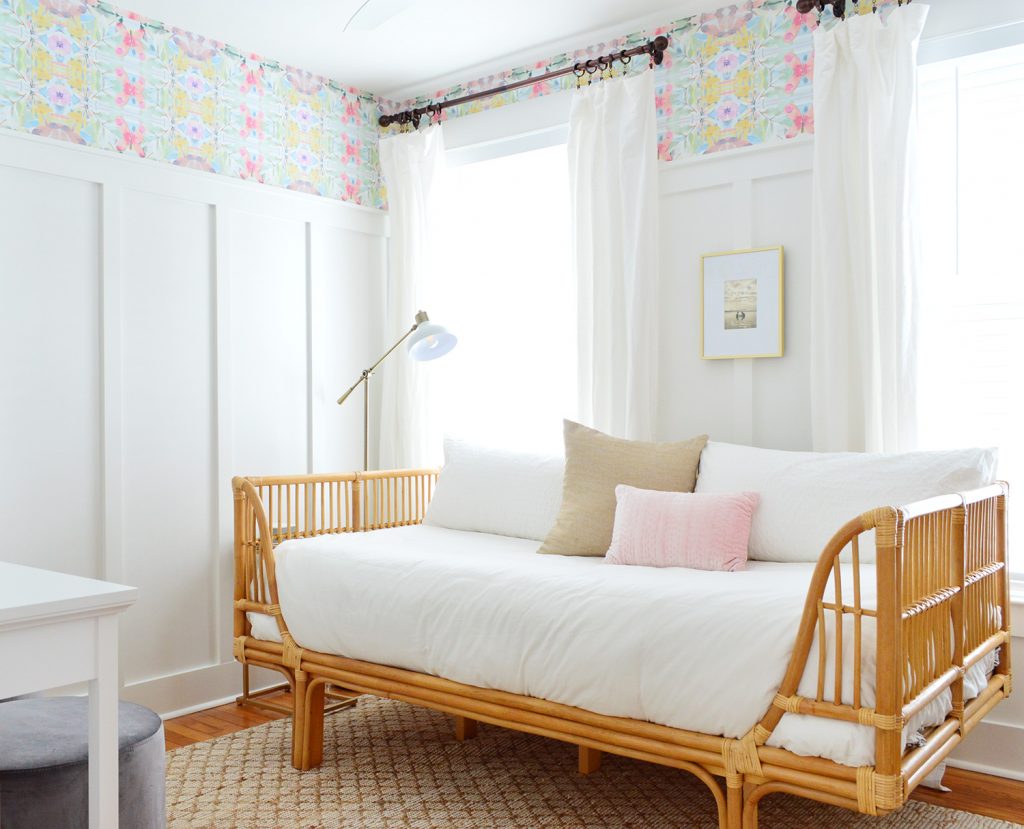

For this specific set up in our seaside home, we did the next board & batten and hung peel-and-stick wallpaper above it. It was precisely the combo of conventional & colourful that we had been going for on this visitor bed room!
What’s Board & Batten?
Board and batten originated as a method of exterior siding, however can be used as inside paneling. It describes a method the place skinny strips of molding – or “battens” – are positioned over the seams between bigger, flat boards. It may be put in floor-to-ceiling or partway up a wall, and battens could be organized vertically, horizontally, and even in containers. It’s standard amongst designers and DIY-ers alike due to its versatility: it may well look conventional & luxe, cottage & informal, and nearly each fashion in between.
How A lot Does Board & Batten Price?
Our board & batten initiatives have price us between about $50 – $650, however this drastically relies on the dimensions of your area and your chosen supplies. We as soon as put in it for slightly as $57 (beneath, left) as a result of we reused our baseboards and picked easy lattice strips for our battens. We tailored that very same approach in our subsequent house however layered on additional moldings to offer a extra conventional look (beneath, proper). That hallway was additionally twice as lengthy, so it price nearer to $300.
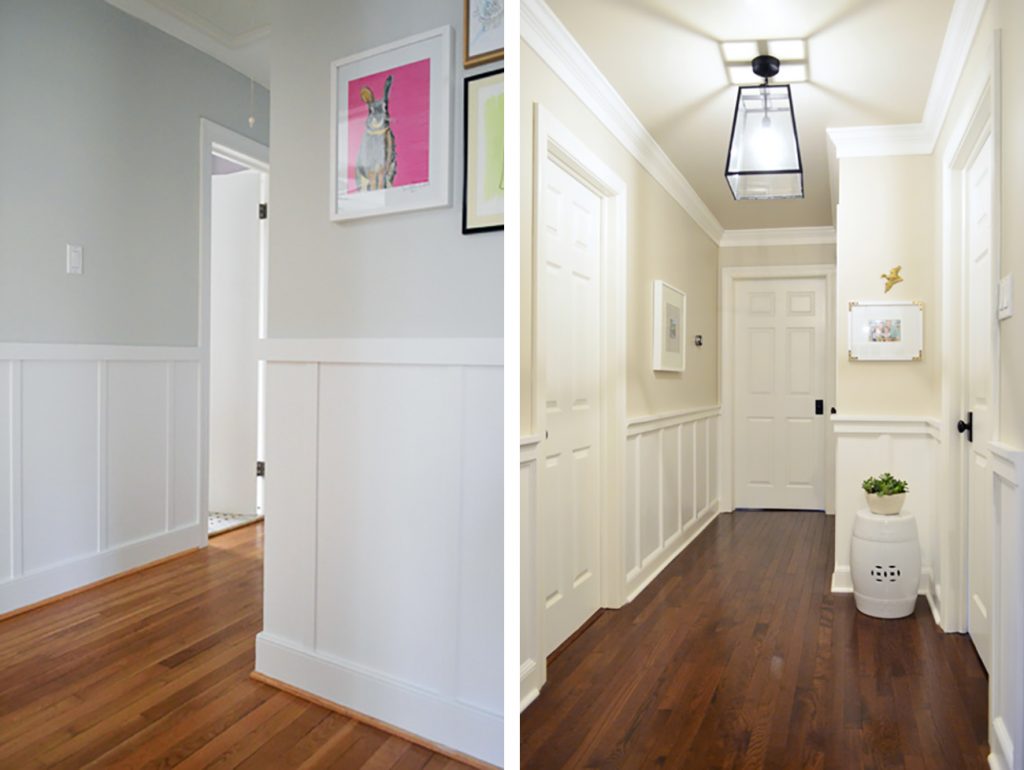

We additionally put in a floor-to-ceiling box-style board and batten in our last bathroom that, as a result of quantity of molding it required, price nearly $650. That was our priciest molding challenge, however it match the high-end look we had been aiming for.
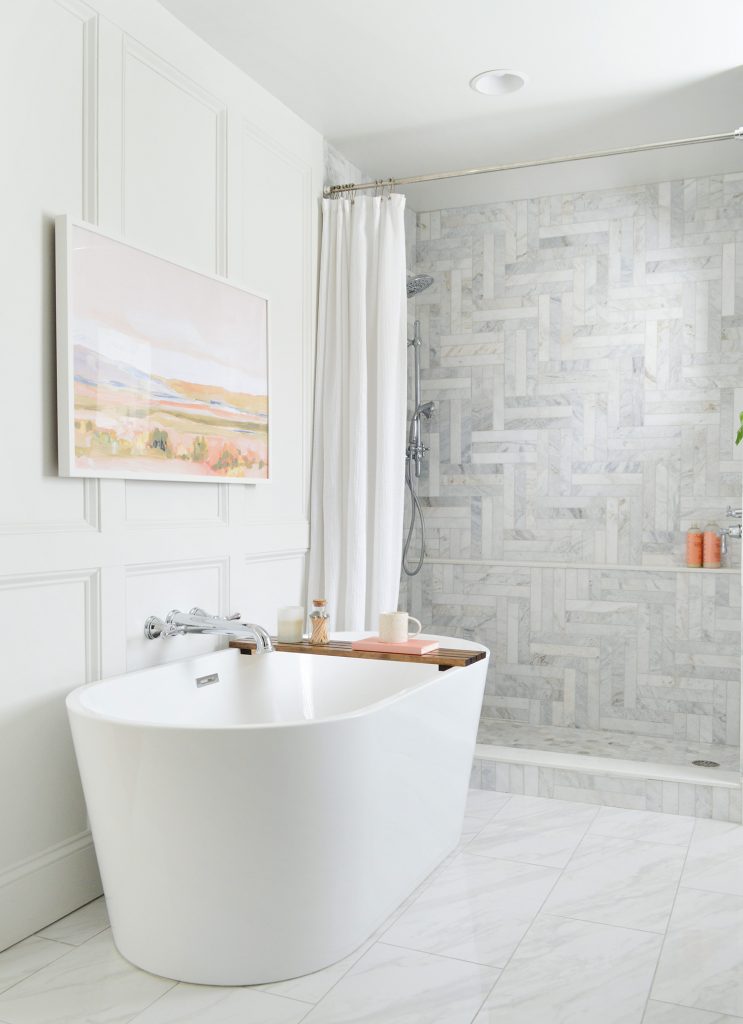

The purpose being: board and batten could be an costly challenge – however it doesn’t must be! The challenge we’re displaying you right now was about $195. It may cost extra in case your room is greater, however you can even maintain the associated fee down by not going so excessive up the wall.
Instruments & Supplies
Prepared for a secret? We’ve saved prices down for all of those initiatives by not putting in the “board” a part of our board & batten. As a substitute, we merely set up battens towards the drywall and paint every little thing to match. This protects time, labor, supplies, and cash whereas trying simply pretty much as good.
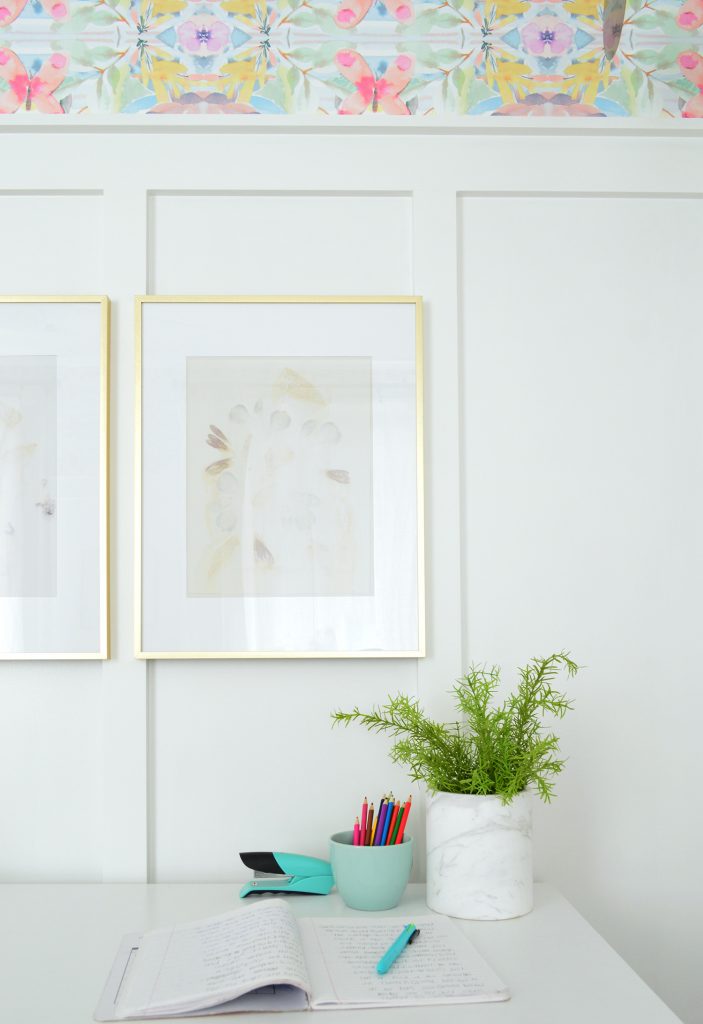

It solely took us half a day to put in ours, however due to varied drying instances between caulk, spackle, primer, and paint – it wasn’t fully performed till the following day. However once more, it’s not an excellent time-intensive challenge. Perhaps six strong hours of labor damaged up throughout two days. So listed here are the fundamental steps.
Step 1: Plan Spacing
We cowl our planning in additional element in this post, however the necessary factor right here is to find out the HEIGHT of your high rail, and the SPACING of your battens. We used a measuring tape and blue painter’s tape to mock ours up in a couple of alternative ways to assist us decide what our eyes appreciated finest.


We chosen the broader 18″ spacing of the battens, and aimed to position our high rail about 20″ down from the ceiling. We selected this top to attenuate the quantity of wallpaper wanted. We had been additionally aware of the place it intersected with our doorways and home windows, ensuring that it seemed deliberately decrease than them.
Step 2: Mark Studs
Subsequent, use a stud finder to find and mark the location of your studs throughout your room. We’ve fallen laborious for this magnetic Stud Buddy as a result of it’s very reliable. You sweep it throughout the wall till the robust magnet catches on the nails in your studs. Because it’s magnetized, it stays in place so you’ll be able to mark issues hands-free. Mark your studs with a pencil or use items of painter’s tape like I did. I put one excessive and one low, simply to be protected.


That is necessary since you’ll need your high boards to be held securely into the wall and hitting a stud along with your nail gun is one of the simplest ways to do it.
Step 3: Prep Baseboards
This step relies on your present baseboard state of affairs. On this room, the baseboards are only a 1 x 6″ board with a bit of ornamental trim alongside the highest. The 1 x 6″ supplies the right backside rail for our board and batten, so we simply wanted to take away the ornamental piece so our battens may sit flush towards it.
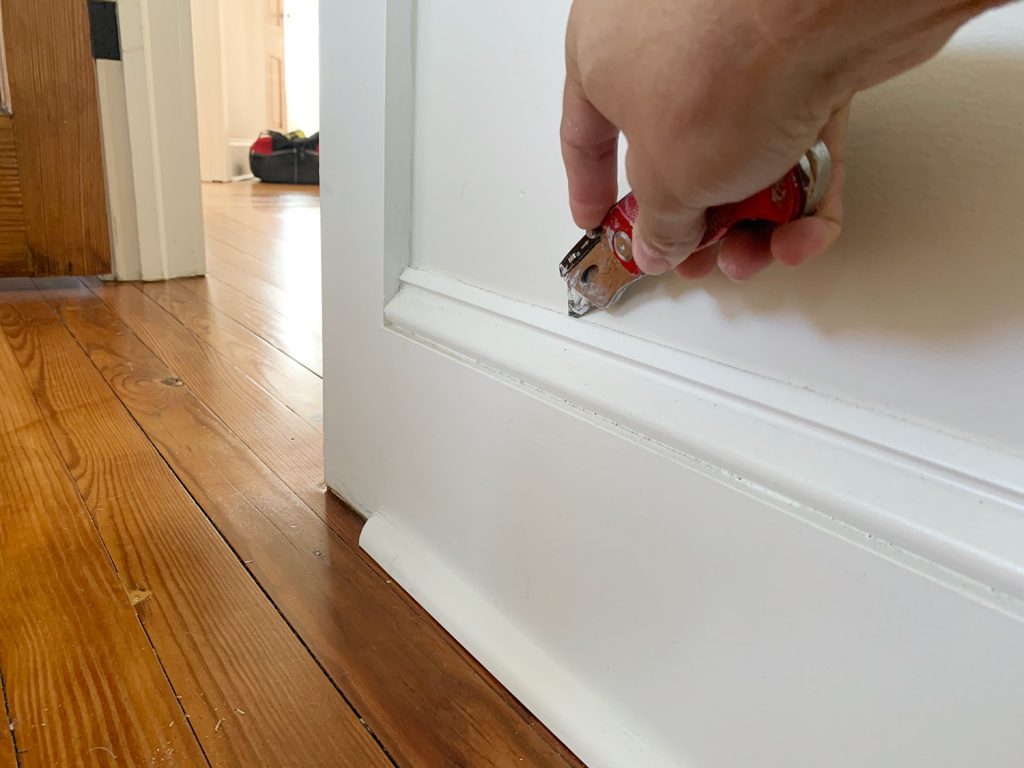

After scoring the highest edge with a utility knife (you can even use the sharp nook of a spackle knife or painter’s tool) we pried off the small ornamental piece on high. The scoring is useful to attenuate injury to the drywall behind it.
And talking of harm, after eradicating this piece you’ll have some clean-up to do to make the wall as clean as potential behind it. We needed to scrape off a number of the remaining caulk and even patch a couple of nail holes with spackle.
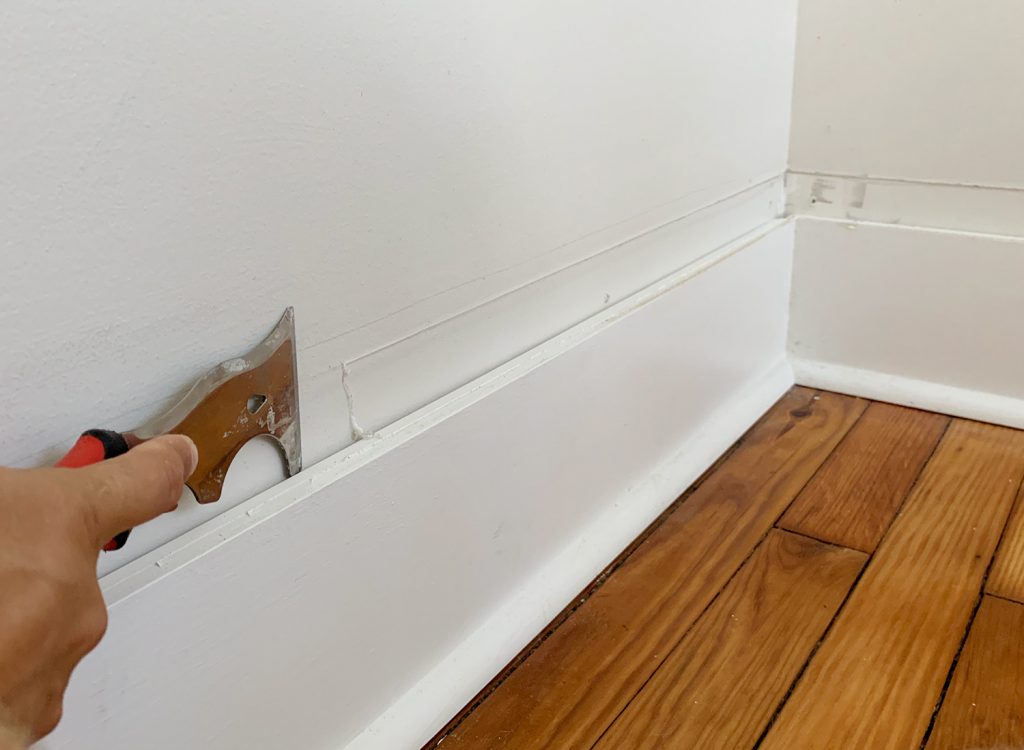

You additionally would possibly think about changing your current baseboard with a 1 x 6″ board should you don’t have already got a great backside edge on your battens to sit down towards. In our previous hallway projects, we used thinner lattice strips as battens as a result of they lined up effectively with our thinner baseboards. However having performed it each methods, we desire the extra substantial baseboard & thicker battens seen right here.
Step 4: Set up Prime Rail
Step one is hanging the highest rail (the 1 x 4″ board) horizontally across the room. This ought to be simple since you’ve already decided your top and marked your studs. An airless nail gun like ours makes it fairly quick too.


Simply be sure you maintain a long level useful as you do that. Our seaside home is 115 years previous, so not one of the ceilings or flooring are completely straight (wonky partitions = character… proper?). So it’s possible you’ll wish to match your degree to the slope of the ceiling as an alternative of blindly going by what the extent says. That can assist your ultimate set up look essentially the most degree to your eye as a result of it’ll look parallel to the closest airplane.
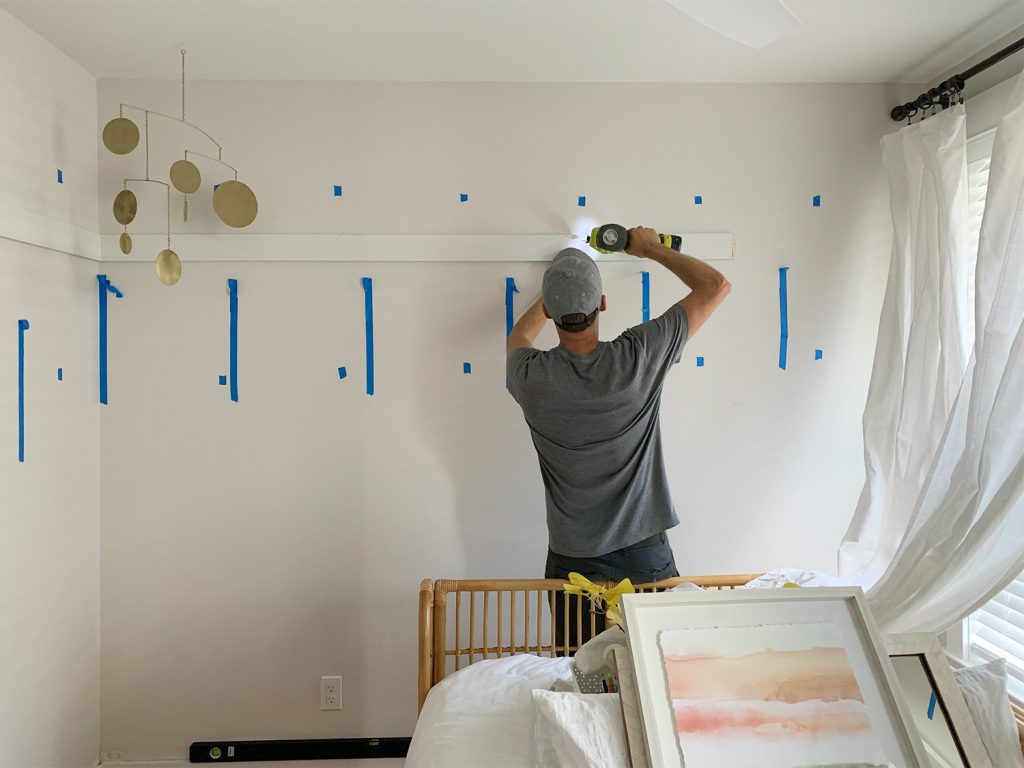

We use our miter saw to chop the boards to size, however you’ll be able to lower by hand should you’d desire. You’ll be able to even get House Depot to make the cuts for you when you’ve got measured them out beforehand. We didn’t do any angled or mitered cuts within the corners, so it’s fairly easy. The one angled lower we did was on the wall you see above the place we had to make use of two board items to span the entire wall. The angled lower helps to cover the joint greater than straight cuts, however it’s not mandatory.
Step 5: Set up Vertical Battens
Now that you simply’ve warmed up your measuring, slicing, and nailing muscle groups, it’s time for the primary occasion: putting in your vertical battens. It’s actually not rocket science – particularly should you’ve already decided your spacing – however the forwards and backwards of this course of can get a bit tedious. I desire to measure every one earlier than I lower it simply to be protected (once more, our partitions aren’t completely degree). This helps to make sure that your battens match as snugly as potential.


The opposite factor I extremely suggest is making a “spacer” out of scrap wooden. You’ll be able to see mine within the photograph above (it’s between the 2 center battens floating beneath the highest rail). This makes it simple to make sure every vertical batten is evenly spaced with out having to interrupt out a tape measure every time. Since my 2.5″ huge battens are 18″ aside from heart to heart, my spacer is lower to fifteen.5″ huge.
Some individuals apply glue or caulk behind these battens, since your nails aren’t all the time hitting studs. I don’t like to do this due to the additional injury it will go away on the wall if we ever resolve to take away the wall therapy. I’ve discovered that they keep in place a lot effectively with a couple of nails up and down the board, plus the caulked edges and the paint you’ll be including subsequent. Simply don’t hold something actually heavy (like a coat hook) except that batten has been nailed to a stud.
Step 6: Thoughts The Corners
Maybe you’ve ironed this out in your planning step, however typically the spacing can get a bit tough relying on the size of your wall. We usually tried to heart one batten within the room, after which set up them evenly at 18″ till we acquired to the corners (or a door or window). You already know, if that final one acquired “lower off” within the nook, so be it.


However we found by means of some trial and error that the corners seemed finest when two “full” battens met one another. By full I imply that they didn’t overlap within the nook, which might’ve made one look skinnier than the opposite.
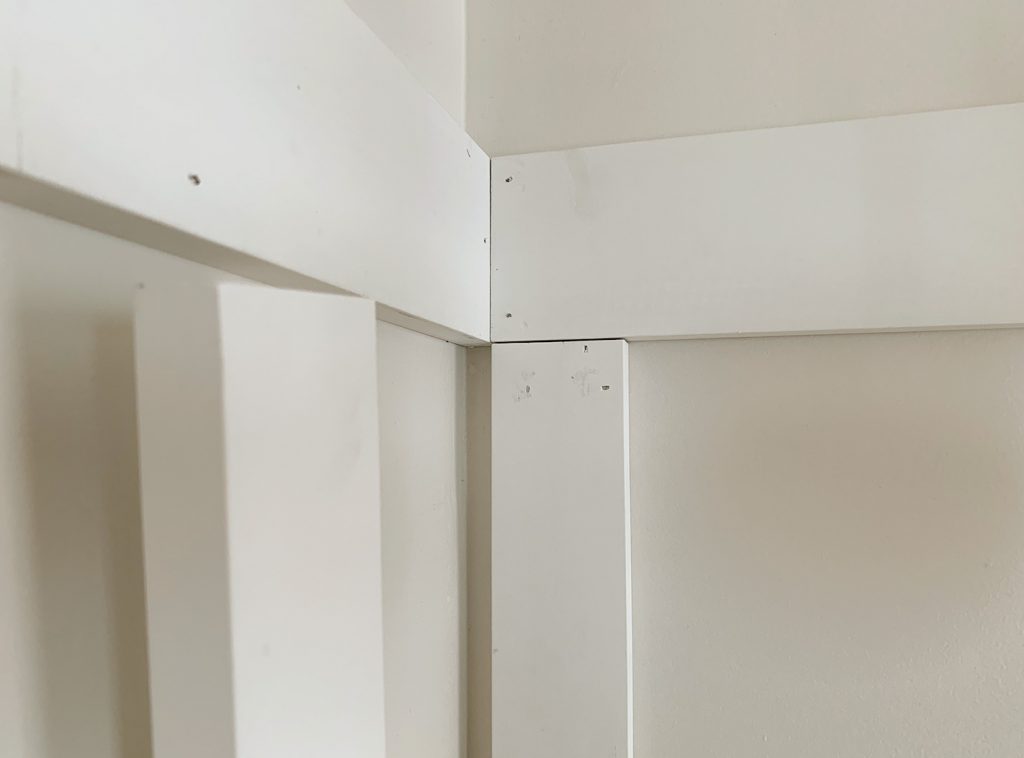

In order you’ll be able to see within the photograph above, this meant not pushing our nook battens absolutely into the nook. As a substitute, they floated off the nook ever so barely so not one of the nook battens overlapped one another. This manner they each appeared full dimension as an alternative of 1 trying slimmer than the opposite.
Step 7: Add Prime Ledge
After skipping a high ledge for our first board & batten challenge, we’ve since determined it’s value the additional effort. A flat ledge seems to be extra substantial and creates a spot to lean paintings or one thing on high. So as to add it, we used a 1 x 2″ board simply nailed alongside the highest.
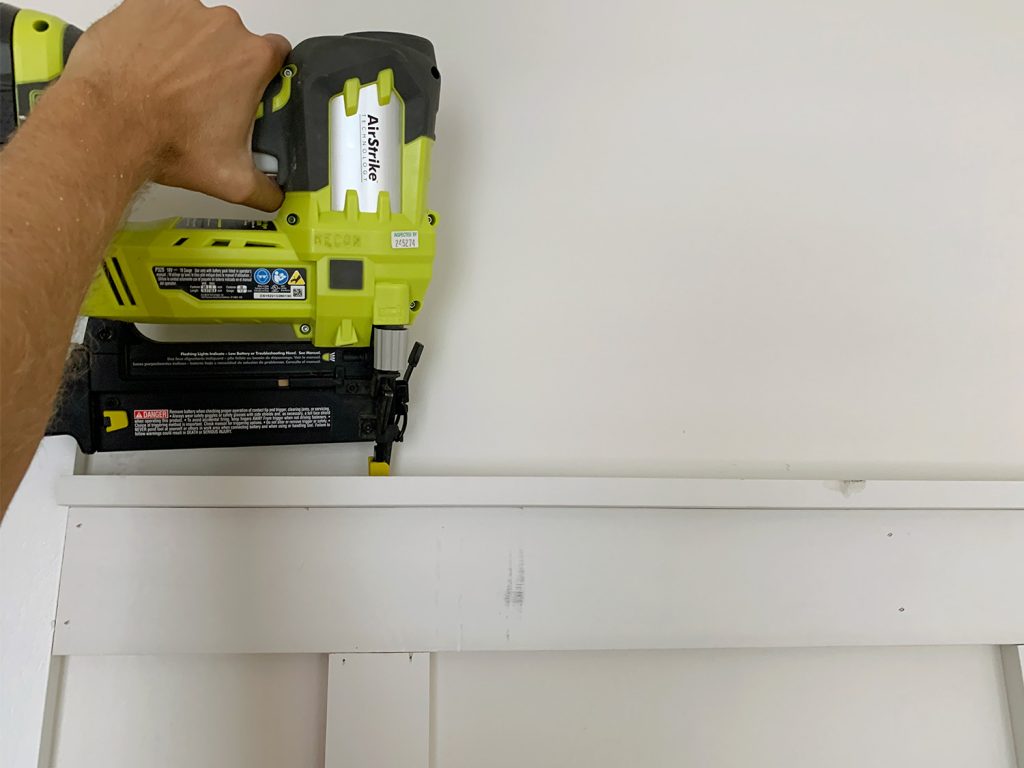

We don’t plan to lean something on ours, however should you do (notably one thing heavy) it’s possible you’ll wish to think about using screws as an alternative of or along with your nails.
Step 8: Spackle & Sand Nail Holes
Earlier than you paint, you’ll wish to fill your whole nail holes. Lots of our podcast listeners mentioned this 4-in-1 spackle tool is ideal for a job like this. And also you guys had been proper. And spackle knife would do, however this fashion was so quick!
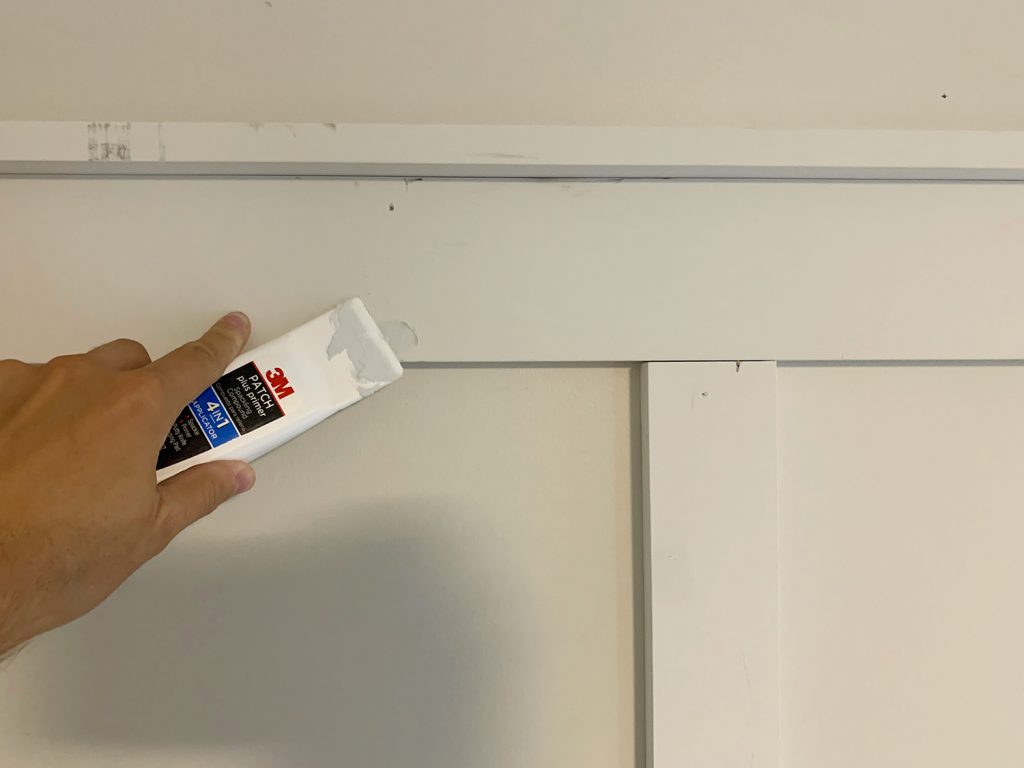

To make use of it, you squeeze a dot of spackle out of the tube after which flip it round to clean it with the flat edge on the again. It has a sanding pad on the cap too, however we discovered it simpler to make use of a bigger, common sanding block.


Make sure you mud off the sanded areas too earlier than you paint. A microfiber fabric or paper towel works nice for this.
Step 9: Caulk Seams
Subsequent, caulk any seam the place your boards meet the wall or each other. This helps disguise any bows in your wall and makes the board and batten appear to be it’s a part of the wall – not simply one thing nailed on high of it.
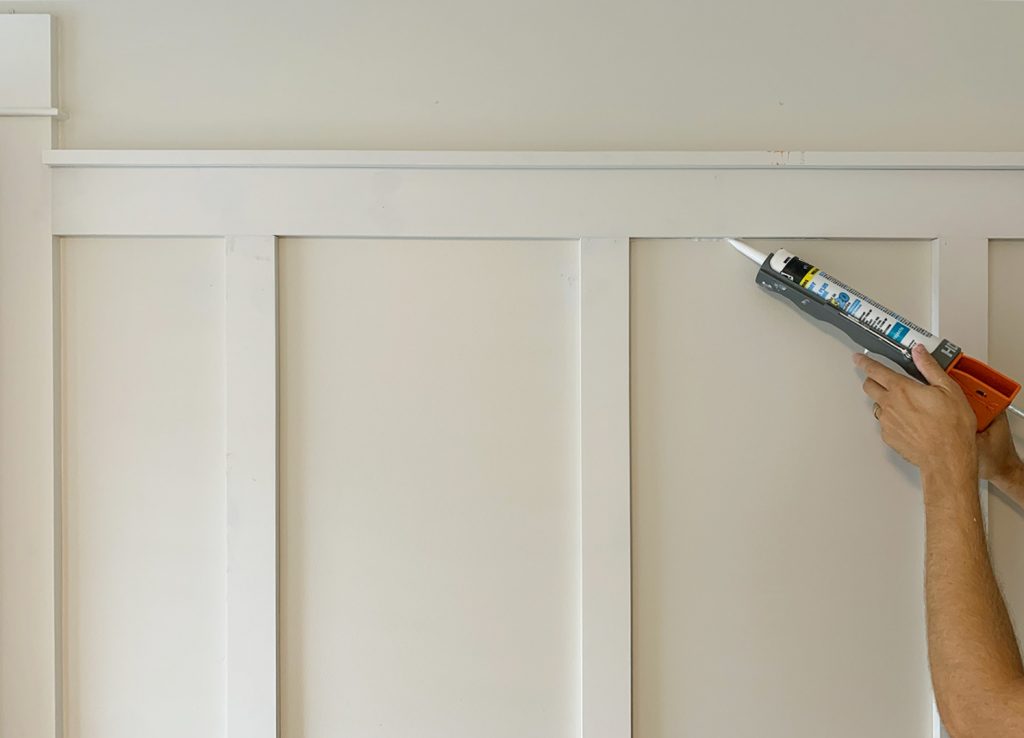

We love this Extreme Stretch caulk as a result of it resists cracking and separating when the temperature or humidity in your home modifications. Our native retailer was out of it so we used this fast dry stuff instead, which can be fairly good – particularly should you’re desirous to get portray.
You most likely gained’t want a thick line of caulk for this challenge, so watch out to not lower an excessive amount of off the tip of your caulk tube (even higher should you can lower it at a slight angle and maintain it good and small). That can assist this half go quicker and also you’ll keep cleaner. You’ll be able to all the time lower off extra if wanted.
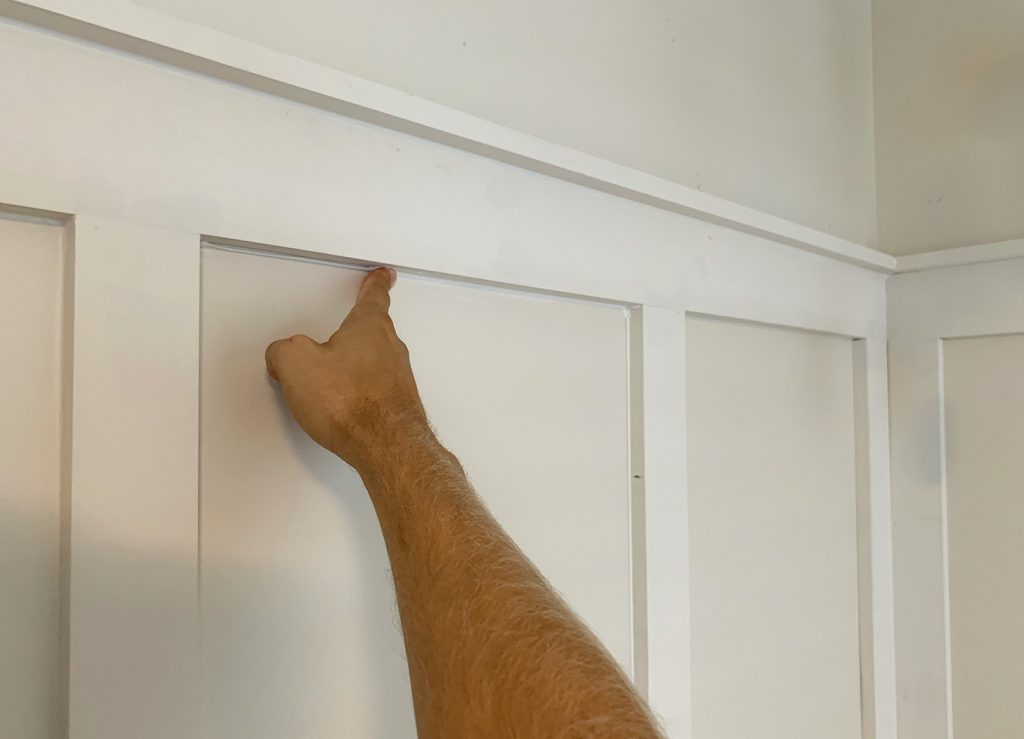

We discovered it was quickest to squeeze out a skinny line of caulk round all 4 sides of a selected “field” suddenly, slightly than stopping to clean all sides one by one. Dip your finger right into a cup of heat water earlier than smoothing the caulk line yields a smoother outcome – and retains the caulk from sticking to your finger.
So there’s the board & batten tutorial for everybody who has been ready for it – and for anybody who desires to see the room accomplished (and be taught all about how we hung the wallpaper & learn our suggestions for that course of) that’s coming! We simply must take some photographs with the great digicam & write that each one up for you (we even made a video tutorial for that one). Within the meantime, listed here are another DIY wall therapy initiatives you would possibly wish to attempt:
Board & Batten FAQs


Is board & batten outdated?
Nope! Board and batten is a timeless look that may be tailored to many types and purposes. To maintain it from trying dated, paint it a crisp white (we love SW Pure White) or one other on-trend shade.
What sort of wooden can you utilize for board & batten?
You need to use many forms of wooden or MDF to get the board & batten look. We like to make use of pre-primed pine or lattice strips for our battens as a result of it saves time. In case you are putting in boards over your drywall, MDF panels gives you a smoother end than plywood. Simply don’t use MDF in a humid location like a rest room or kitchen as a result of moisture could cause it to warp. If putting in open air, be sure you use stress handled wooden or cedar to face up to the weather.
The place does board & batten look finest?
There are not any laborious guidelines about the place board & batten can be utilized. It’s standard for hallways & entryways, in addition to bedrooms & eating rooms. Simply make certain your wall area is giant sufficient to suit no less than 3 panels, so the repetition is smart.
How excessive ought to board & batten be?
Board & batten sometimes seems to be the most effective between 1/2 and a couple of/3 up your wall. It could even go all the way in which to the ceiling! We propose utilizing painter’s tape to visualise the most effective top on your area, conserving in thoughts the peak of ceilings, doorways, and paintings. We suggest erring on the facet of upper than decrease, particularly if going that “midway” look. A real midway measurement typically seems to be too low, so think about dishonest it a bit larger.
How far aside ought to board & batten be?
We propose spacing your vertical battens between 12″ and 20″ aside. The bigger your room, the broader it’s possible you’ll wish to area them. We suggest testing your area with painter’s tape first. And do not forget that totally different partitions in your could require barely totally different spacing as a way to forestall small or cut-off sections within the corners.
Can you put in board & batten on textured partitions?
Sure, however you gained’t be capable to use your current drywall because the “boards” like we do on this tutorial. As a substitute, you’ll wish to set up skinny, clean boards over your drywall earlier than including your battens. We propose a skinny MDF that’s screwed into wall studs to attain this.
Extra DIY Wall Therapies
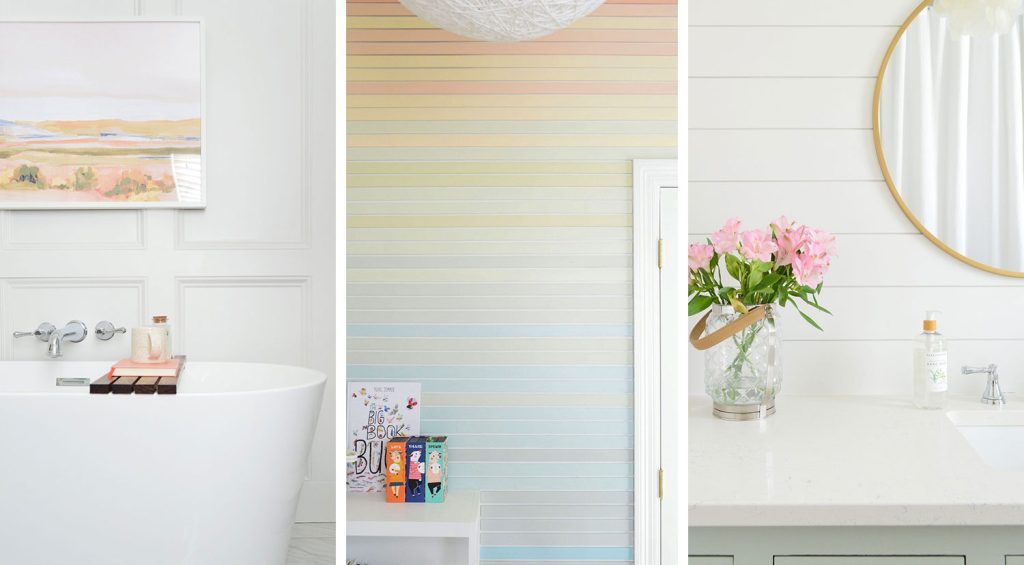

On the lookout for extra concepts so as to add architectural curiosity to your partitions? Listed here are extra of our favourite DIY-friendly wall therapy initiatives, together with different iterations of this board & batten:
*This submit accommodates affiliate hyperlinks*




